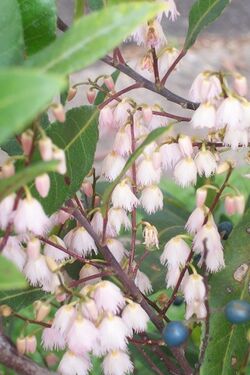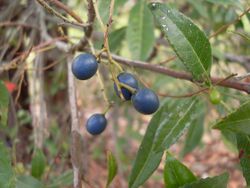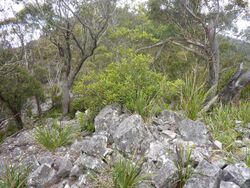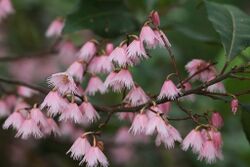Biology:Elaeocarpus reticulatus
| Blueberry ash | |
|---|---|

| |
| Elaeocarpus reticulatus flowers and fruit | |
| Scientific classification | |
| Kingdom: | Plantae |
| Clade: | Tracheophytes |
| Clade: | Angiosperms |
| Clade: | Eudicots |
| Clade: | Rosids |
| Order: | Oxalidales |
| Family: | Elaeocarpaceae |
| Genus: | Elaeocarpus |
| Species: | E. reticulatus
|
| Binomial name | |
| Elaeocarpus reticulatus | |
| Synonyms[1] | |
| |
Elaeocarpus reticulatus, commonly known as blueberry ash, ash quandong, blue olive berry, fairy petticoats, fringe tree, koda, lily of the valley tree and scrub ash,[2] is species of flowering plant in the family Elaeocarpaceae, and is endemic to eastern Australia. It is a shrub or small tree with oblong to elliptic leaves, racemes of white or pink flowers and blue, oval to spherical fruit.
Description
Elaeocarpus reticulatus is a shrub or small tree that typically grows to a height of 3–10 m (9.8–32.8 ft), but up to 30 m (98 ft) in some situations, and has a lignotuber at its base. The leaves are simple, (strictly compound with only one leaflet), oblong to elliptic, mostly 50–130 mm (2.0–5.1 in) long and 10–40 mm (0.39–1.57 in) wide on a petiole 5–20 mm (0.20–0.79 in) long. The leaves are more or less glabrous, often turn red before falling, have regular teeth along the edges, small domatia and a prominent network of veins on both surfaces. The flowers are arranged in racemes up to 50–80 mm (2.0–3.1 in) long, with between five and ten flowers, each on a pedicel 4–8 mm (0.16–0.31 in) long. The five sepals are narrow triangular 5–6 mm (0.20–0.24 in) long and about 1 mm (0.039 in) wide. The five petals are white, sometimes pinkish, 6–7 mm (0.24–0.28 in) long and about 2 mm (0.079 in) wide, the tip with between seven and ten linear lobes. There are between thirteen and fifteen stamens and the style is 3–4 mm (0.12–0.16 in) long. Flowering occurs from October to January and the fruit is a more or less spherical, oval or elliptical blue drupe about 12 mm (0.47 in) long.[2][3][4][5][6][7]
Taxonomy
Elaeocarpus reticulatus was first formally described in 1809 by James Edward Smith in Abraham Rees's The Cyclopaedia from specimens collected near Port Jackson by John White.[8][9] The specific epithet (reticulatus) means "with the appearance of a net".[10]
Distribution and habitat
Blueberry ash often grows in tall eucalypt forest, in or near rainforest, often in moist gullies, but also found on stony ridges. It occurs along the east coast of Australia from Fraser Island in Queensland to Flinders Island in Tasmania. In New South Wales it is found from sea level to the ranges and in Victoria to the east of Wilsons Promontory where it is often locally common.[2][3][6][7]
Ecology
The fruits of E. reticulatus are eaten by birds, including wonga pigeons, crimson rosellas, figbirds, white-headed pigeons and olive-backed orioles and the regent bowerbird collects them to decorate its bower.[11]
Use in horticulture
Blue berry ash is described as "an outstanding specimen tree for coastal gardens". Propagation of the plant can be achieved from semi-hardwood cuttings taken in warmer weather, but germination from seed can take several years. The shrub is hardy in most situations and can be grown in shade to full sun.[11][12]
References
- ↑ 1.0 1.1 "Elaeocarpus reticulatus". Australian Plant Census. https://biodiversity.org.au/nsl/services/apc-format/display/69502.
- ↑ 2.0 2.1 2.2 "Elaeocarpus reticulatus". Royal Botanic Garden Sydney. https://plantnet.rbgsyd.nsw.gov.au/cgi-bin/NSWfl.pl?page=nswfl&lvl=sp&name=Elaeocarpus~reticulatus.
- ↑ 3.0 3.1 Jeanes, Jeff A.. "Elaeocarpus reticulatus". Royal Botanic Gardens Victoria. https://vicflora.rbg.vic.gov.au/flora/taxon/f2f6c4ef-df0e-4b63-81e4-4f6b478a04ae.
- ↑ Wood, Betty. "Elaeocarpus reticulatus". Lucid Central. https://apps.lucidcentral.org/plants_se_nsw/text/entities/elaeocarpus_reticulatus.htm.
- ↑ Hyland, Bernard; Coode, Mark J. (1984). "Elaeocarpus in Australia and New Zealand.". Kew Bulletin 39 (3): 557–559.
- ↑ 6.0 6.1 Floyd, Alexander G. (1989). Rainforest trees of mainland South-eastern Australia. Melbourne: Inkata Press. p. 117. ISBN 0-909605-57-2.
- ↑ 7.0 7.1 Robinson, Les (1991). Field guide to the native plants of Sydney. Kenthurst, NSW: Kangaroo Press. p. 164. ISBN 0864171927.
- ↑ "Elaeocarpus reticulatus". APNI. https://id.biodiversity.org.au/instance/apni/479338.
- ↑ Smith, James E.; Rees, Abraham (ed.) (1809). The Cyclopaedia. 12. London: Longman, Hurst, Rees, Orme & Brown. https://biodiversity.org.au/nsl/services/rest/instance/apni/479338. Retrieved 22 February 2021.
- ↑ Sharr, Francis Aubi; George, Alex (2019). Western Australian Plant Names and Their Meanings (3rd ed.). Kardinya, WA: Four Gables Press. p. 293. ISBN 9780958034180.
- ↑ 11.0 11.1 Brown, Liz. "Elaeocarpus reticulatus". Australian National Botanic Gardens. http://anbg.gov.au/gnp/interns-2002/elaeocarpus-reticulatus.html.
- ↑ Wrigley, John W.; Fagg, Murray (1983). Australian native plants : a manual for their propagation, cultivation and use in landscaping (2nd ed.). Sydney: Collins. p. 332. ISBN 0002165759.
Wikidata ☰ Q3013110 entry
 |




